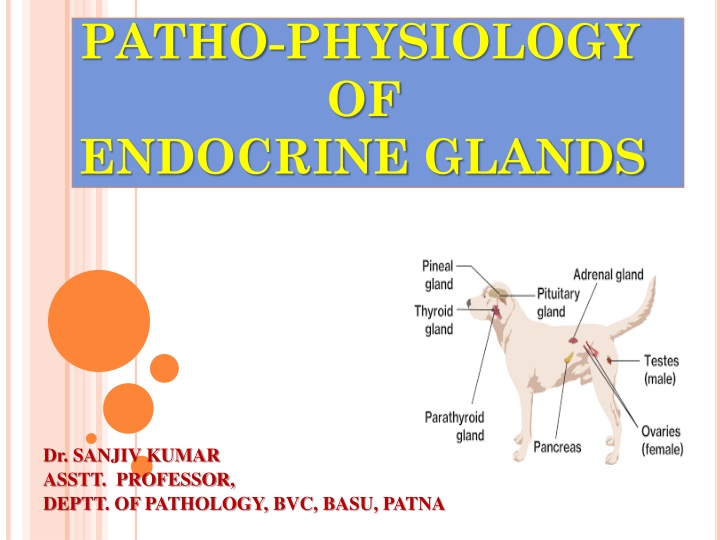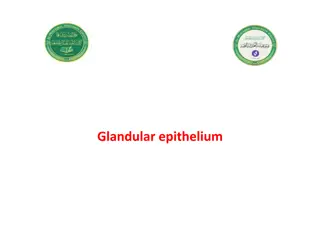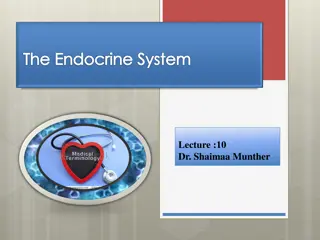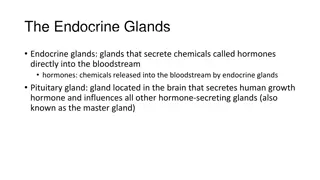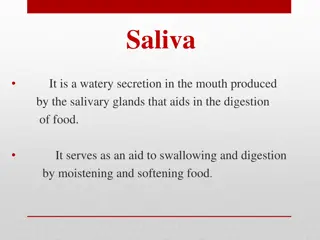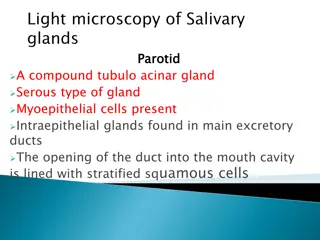Patho-Physiology of Endocrine Glands
Endocrine disorders can be categorized into hyposecretion, hypersecretion, and tumors affecting endocrine glands. Conditions like hyperpituitarism manifest as gigantism or acromegaly, while hypopituitarism can lead to pituitary dwarfism. Understanding the pathophysiology of endocrine glands helps in diagnosing and managing such conditions effectively.
Download Presentation

Please find below an Image/Link to download the presentation.
The content on the website is provided AS IS for your information and personal use only. It may not be sold, licensed, or shared on other websites without obtaining consent from the author.If you encounter any issues during the download, it is possible that the publisher has removed the file from their server.
You are allowed to download the files provided on this website for personal or commercial use, subject to the condition that they are used lawfully. All files are the property of their respective owners.
The content on the website is provided AS IS for your information and personal use only. It may not be sold, licensed, or shared on other websites without obtaining consent from the author.
E N D
Presentation Transcript
PATHO-PHYSIOLOGY OF ENDOCRINE GLANDS Dr. SANJIV KUMAR ASSTT. PROFESSOR, DEPTT. OF PATHOLOGY, BVC, BASU, PATNA
Endocrine disorders may be subdivided into three groups: Endocrine gland hyposecretion (leading to hormone deficiency) Endocrine gland hypersecretion (leading to hormone excess) Tumours (benign or malignant) of endocrine glands
HYPERPITUITARISM This condition is manifested by overgrowth and proliferation of bones. In man this is called Gigantism in young growing individuals in whom the ossification of bone has not yet stopped and Acromegaly in adults in whom no more growth occurs. Gigantism Gigantism is due to increased secretion of somatotropin in the young. The individual grows very tall and the skin and subcutaneous tissues show fibrous hyperplasia. Since STH is diabetogenic, glycosuria is a symptom. If the patient lives beyond the age of epiphyseal fusion acromegaly may result.
Acromegaly (akros=extremity; megale=enlarged) The hands and the feet are abnormally large and the fingers are crooked and knotty. The facial bones become long and thick, especially the jaw, resulting in prognathism. Nose, lips and ears become large. Viscera are enlarged (splanchnomegaly or macrosplanchnia) and fibrous hyperplasia of skin and subcutaneous tissue. Kyphosis is also seen in some. Impotence in the male and amenorrhoea in the female are the other symptoms. Diabetes mellitus occurs due to diabetogenic action of the hormone. Eye lesions may be noticed due to pressure on the optic chiasma by the tumor
HYPOPITUITARISM Causes of pituitary hypofunction Pressure by: Inflammation and sclerosis Infarction and necrosis Hydrocephalus bulging of the floor of the ventricles Abnormal development Tuberculosis a) Tumors b) Cysts Pituitary dwarfism or infantilism Hypofunction in the young children causes in pituitary Dwarfism or Infantilism. This condition is not seen in animals.
Simmonds disease (Pituitary cachexia) or Sheehans Syndrome This condition is described in female dogs, due to postpartum necrosis of the pituitary consequent on thrombosis following hemorrhage. Clinical signs Severe cachexia, loss of sexual function, weakness, low metabolic rate, loss of hair and pigmentation, mental apathy, drowsiness, microsplanchnia, emaciation. extreme dehydration and Lesions Atrophy and fibrosis of the thyroid, adrenal glands, ovaries and parathyroids together with consequent on the deficiency of the hormones secreted by these glands and structures. the symptoms and lesions
Frohlichs Syndrome- Dystrophia adiposogenitalis This develops probably due to the pressure by a tumor or hydrocephalus and is mostly found in females. Decreased level of gonadotrophins. Clinical signs Obesity: There is disproportionate accumulation of fat. Genital hypoplasia and decreased sexual function Idiocy or mental retardation Thin skin and hair Reduced sweat secretion
DIABETES INSIPIDUS In Hypo secretion of ADH, reabsorption of water from the glomerular filtrate does not occur and so large quantities of urine with low specific gravity are passed and this condition is known as diabetes insipidus. Lesions of the pars nervosa or any causes that injure the hypothalamus will produce diabetes insipidus. Causes are: Trauma- surgical or fractures Pituitary tumor or metastases form. Meningitis- pressing on the stalk/ Encephalitis.
TUMOURS OF PITUITARY GLAND Chromophobe adenoma, acidophilic adenoma and basophilic adenoma of pituitary were rarely reported. Carcinoma of the above three types of cells may be noticed. But these are only locally invasive.
Pineal gland is a tiny gland located above the posterior extremity of the third ventricle of brain. It secrets a hormone called melatonin. Melatonin antagonizes the action of the melanocyte stimulating hormone. It inhibits thyroid hormone secretion rate and secretion of the adrenal steroids. Pineal dysfunction Pineal hyperfunction is associated with delayed puberty. Pineal hypofunction results in precocious puberty. Neoplasms of pineal gland Tumors reported in pineal gland include pinealoma, glioma and teratoma.
